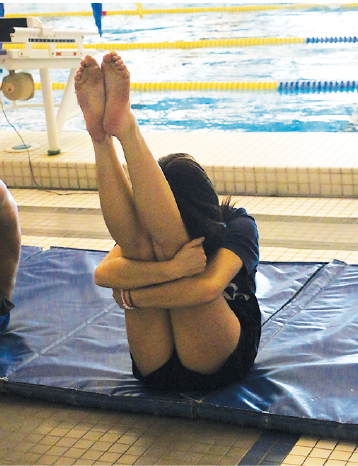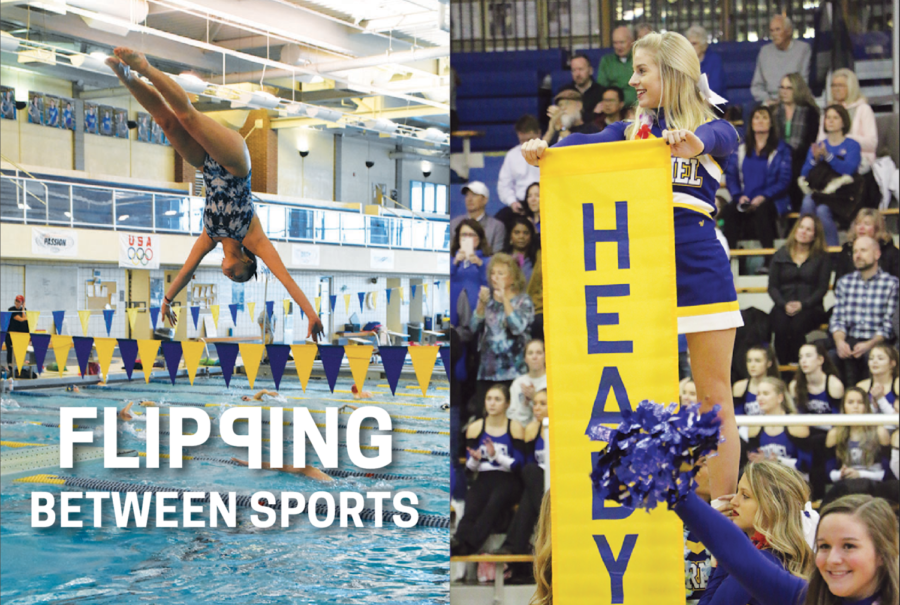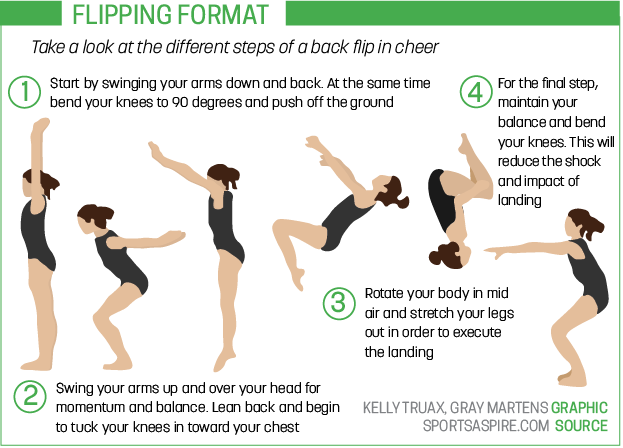Sophomore Jenna Springirth takes a deep breath and then flips through the air. The water folds around her as she finishes her perfectly executed dive. Springirth is a member of this year’s women’s swimming and diving team, but she is also a member of the varsity competition cheerleading squad. At first glance, diving and cheerleading do not seem like comparable sports. However, the skills required are similar, allowing many athletes, like Springirth, to be successful in both.

FRIEND STRETCH:
Elie Anania and Veronica Light, gold winter cheerleaders and juniors, help Blair Wayman, gold winter cheerleader and sophomore, stretch. Wayman stretched before stunting during practice.
Sports medicine teacher Emily Good talked about the physiological capacity relating to an athlete’s success in both sports.
“When you look at sport-specific skills in both sports you’re definitely looking at core (strength), but also power since you need to be able to push off the ground or the board,” Good said. “Additionally, there are plyometric and dynamic movements where either you have those big explosive movements, like jumps, or the more stagnant stretches. Both of these are found in cheer and diving, so a background in one may help someone’s success in another.”
For Springirth, her introduction to these skills came through gymnastics.
“I’ve had a long gymnastics background beginning from when I was very young,” she said. “There I was able to work on my flexibility and power. That has really helped me in both cheer and diving. Gymnastics has also really helped me with keeping good technique by staying tight throughout the movement and preparing for the landing impact.”
With a strong background in gymnastics, Springirth said she was able to transition into cheerleading. Later she decided to try out a new sport: diving.
Springirth said, “When I decided to try diving, I was told by a couple of my friends who were involved in both cheer and diving that the skill sets were pretty similar. I wanted to try something new and decided that a sport with a similar skill set that I had already mastered would be good.”
After becoming a diver, Springirth said she found there really were numerous physical similarities between the two sports.

Flexibility Training:
Jenna Springirth, winter cheerleader, diver and sophomore stretches at the start of practice. After stretching, she performed several dives focusing on specific skills each time.Springirth does both cheerleading and diving because of the similar movements involved in the two.
“(The) first (similarity) is being powerful and energetic, especially when you are beginning the movement. If you do not have the right amount of energy, it can be really hard to execute the skill correctly since you may not have enough time to do the correct number of flips or spins,” Springirth said. “Flipping is a big aspect in both cheer and diving. Coming from a background of cheer, the flips I have already mastered can be used in diving to help gain those harder and more elite skills that can gain you more points.”
According to Springirth, the point systems in diving and cheer are also similar.
“Keeping technique is also important because in cheer there is a separate scoring sheet specifically for good technique and in diving bad technique can result in injury as well as the loss of points.”
Winter cheerleader and diver Blair Wayman found that the mental aspects of the two sports were similar.
“A big component of both sports is mental awareness. You need to have body control throughout a flip or a dive to make sure that you are successfully completing each skill.”
Although the two sports have similarities, there are also some differences athletes have to work on before being able to smoothly transition from cheerleading to diving.
“Spotting where you are in a flip is a big deal, but it is a little different between the two sports,” Springirth said. “As a cheerleader you would need to spot your landing with the ground. For diving you would need to spot the water for the entry making sure you do not smack the water. Since diving does end in the water, there is another added aspect to think about.”
Cheerleading coach Jennifer Norlock also noted the difference.
“For cheer, typically with standing tumbling, your goal is to land in the same spot. This is also true in most pyramids where you flip through the air and are caught after the toss. In diving, your goal is to move forward or backward depending on which way you are flipping,” Norlock said.
Wayman is not only involved in competition cheerleading and diving, but also winter cheerleading. According to Wayman, balancing two sports while they are in seasoncreates a conflicting schedule.
Wayman said, “Earlier in the season it was not that bad because the (basketball) games had not picked up. Now that the games have started, the diving schedule and the cheer schedule definitely do conflict a lot, so it is hard to do both.”
Norlock described the schedule for a student involved in both sports and said both sports could be accomodated.
“If they have a diving practice we encourage them to go and they are not deducted for that. For diving, the girls pick so many days out of the week that they have to go to practice and they choose those dates on days where the cheer team does not have practice or a game,” Norlock said.
Regardless of the differences, Springirth decided to remain participating in both sports.
Springirth said, “I participate in cheer and diving because both can fit into my schedule. I also like to be very active throughout the school year too. They are very similar sports in some ways, which makes them very enjoyable to do.”































![What happened to theater etiquette? [opinion]](https://hilite.org/wp-content/uploads/2025/04/Entertainment-Perspective-Cover-1200x471.jpg)














































![Review: “The Immortal Soul Salvage Yard:” A criminally underrated poetry collection [MUSE]](https://hilite.org/wp-content/uploads/2025/03/71cju6TvqmL._AC_UF10001000_QL80_.jpg)
![Review: "Dog Man" is Unapologetically Chaotic [MUSE]](https://hilite.org/wp-content/uploads/2025/03/dogman-1200x700.jpg)
![Review: "Ne Zha 2": The WeChat family reunion I didn’t know I needed [MUSE]](https://hilite.org/wp-content/uploads/2025/03/unnamed-4.png)
![Review in Print: Maripaz Villar brings a delightfully unique style to the world of WEBTOON [MUSE]](https://hilite.org/wp-content/uploads/2023/12/maripazcover-1200x960.jpg)
![Review: “The Sword of Kaigen” is a masterpiece [MUSE]](https://hilite.org/wp-content/uploads/2023/11/Screenshot-2023-11-26-201051.png)
![Review: Gateron Oil Kings, great linear switches, okay price [MUSE]](https://hilite.org/wp-content/uploads/2023/11/Screenshot-2023-11-26-200553.png)
![Review: “A Haunting in Venice” is a significant improvement from other Agatha Christie adaptations [MUSE]](https://hilite.org/wp-content/uploads/2023/11/e7ee2938a6d422669771bce6d8088521.jpg)
![Review: A Thanksgiving story from elementary school, still just as interesting [MUSE]](https://hilite.org/wp-content/uploads/2023/11/Screenshot-2023-11-26-195514-987x1200.png)
![Review: "When I Fly Towards You", cute, uplifting youth drama [MUSE]](https://hilite.org/wp-content/uploads/2023/09/When-I-Fly-Towards-You-Chinese-drama.png)
![Postcards from Muse: Hawaii Travel Diary [MUSE]](https://hilite.org/wp-content/uploads/2023/09/My-project-1-1200x1200.jpg)
![Review: "Ladybug & Cat Noir: The Movie," departure from original show [MUSE]](https://hilite.org/wp-content/uploads/2023/09/Ladybug__Cat_Noir_-_The_Movie_poster.jpg)
![Review in Print: "Hidden Love" is the cute, uplifting drama everyone needs [MUSE]](https://hilite.org/wp-content/uploads/2023/09/hiddenlovecover-e1693597208225-1030x1200.png)
![Review in Print: "Heartstopper" is the heartwarming queer romance we all need [MUSE]](https://hilite.org/wp-content/uploads/2023/08/museheartstoppercover-1200x654.png)




